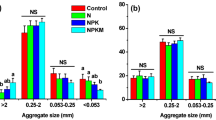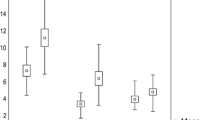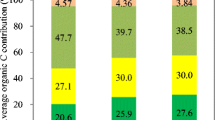Abstract
Understanding the contributions of soil microorganisms to soil stabilization at the molecular level will lead to ways to enhance inputs for sustainable agricultural systems. Recent discoveries of copious production of glycoprotein (glomalin) by arbuscular mycorrhizal (AM) fungi and the apparent recalcitrance of this material in soils led to the comparison between concentration of glomalin and aggregate stability. Stability was measured on air-dried aggregates rewetted by capillary action and then subjected to wet sieving for 10 min. Thirty-seven samples from four geographic areas of the U.S. and one area of Scotland were tested. The monoclonal antibody used to discover glomalin on AM hyphae was employed to assess immunoreactive glomalin on aggregate surfaces by immunofluorescence and in extracts from aggregates by enzyme-linked immunosorbent assay (ELISA). Immunofluorescence was observed on at least some surfaces of aggregates from all soils examined, but was most evident on aggregates with high glomalin concentrations. Easily extractable glomalin (EEG) was solubilized by 20 mM citrate, pH 7.0 at 121 °C for 30 min, and total glomalin (TG) was solubilized with 50 mM citrate, pH 8.0 at 121 °C for 90 to 450 min. Some soils required up to seven sequential extractions to remove all of the glomalin. Aggregate stability was linearly correlated (p < 0.001) with all measures of glomalin (mg/g of aggregates) in these soils. The best predictor of aggregate stability (AS) was immunoreactive easily extractable glomalin (IREEG) according to the following relationship: AS = 42.7 +61.3 × log10 IREEG (r2 = 0.86; p <0.001, n = 37).
Similar content being viewed by others
References
Baldock J A and Kay B D 1987 Influence of cropping history and chemical treatments on the water stable aggregation of a silt loam soil. Can. J. Soil Sci. 67, 501–511.
Baldock J A, Kay B D and Schnitzer M 1987 Influence of cropping treatments on the monosaccharide content of the hydrolysates of a soil and its aggregate fractions. Can. J. Soil Sci. 67, 489–499.
Emerson W W, Foster R C and Oades J M 1986 Organo-mineral complexes in relation to soil aggregation and structure. In Interactions of Soil Minerals with Natural Organics and Microbes. pp 521–548. Soil Science Society of America Special Publication no. 17. Madison, WI, USA.
Gijsman A J and Thomas R J 1995 Aggregate size distribution and stability of an Oxisol under legume-based and pure grass pastures in the Eastern Colombian savannas. Aust. J. Soil Res. 33, 153–165.
Haynes R J and Swift R S 1990 Stability of soil aggregates in relation to organic constituents and soil water content. J. Soil Sci. 41, 73–83.
Jastrow J D 1987 Changes in soil aggregation associated with tallgrass prairie restoration. Amer. J. Bot. 74, 1656–1664.
Kemper W D and Koch E J 1966 Aggregate stability of soils from Western United States and Canada. Technical Bulletin No. 1335. Agricultural Research Service, USDA, Washington, DC, USA.
Kemper W D and Rosenau R C 1984 Soil cohesion as affected by time and water content. Soil Sci. Soc. Am. J. 48, 1001–1006.
Kemper W D and Rosenau R C 1986 Aggregate stability and size distribution. In Methods of Soil Analysis, Part 1. Physical and Mineralogical Methods. pp 425–444. Agronomy Monograph No. 9, 2nd edn. American Society of Agronomy, Madison, WI, USA.
Low A J 1955 Improvements in the structural state of soils under lays. J. Soil Sci. 6, 179–199.
Millner, P D and Kitt D G 1992 The Beltsville method for soilless production of vesicular-arbuscular mycorrhizal fungi. Mycorrhiza 2, 9–15.
Oades J M 1984 Soil organic matter and structural stability: mechanisms and implications for management. Plant Soil 76, 319–337.
Russo, P S, Blum F D, Ipsen J D, Abul-Hajj Y J and Miller W G 1982 The surface activity of the phytotoxin cerato-ulmin. Can. J. Bot. 60, 1414–1422.
Tisdall J M and Oades J M 1982 Organic matter and water-stable aggregates in soils. J. Soil Sci. 33, 141–163.
Utomo W H and Dexter A R 1981 Effect of ageing on compression resistance and water stability of soil aggregates disturbed by tillage. Soil Tillage Res. 1, 127–137.
Wessels J G H 1993 Tansley Reviews No. 45. Wall growth, protein excretion and morphogenesis in fungi. New Phytol. 123, 397–413.
Wessels J G H 1996 Fungal hydrophobins: proteins that function at an interface. Trends Plant Sci. 1, 9–15.
Wright S F, Franke-Snyder M, Morton J B and Upadhyaya A 1996 Time-course study and partial characterization of a protein on hyphae of arbuscular mycorrhizal fungi during active colonization of roots. Plant Soil 181, 193–203.
Wright S F and Upadhyaya A 1996 Extraction of an abundant and unusual protein from soil and comparison with hyphal protein from arbuscular mycorrhizal fungi. Soil Sci. 161, 575–586.
Author information
Authors and Affiliations
Rights and permissions
About this article
Cite this article
Wright, S., Upadhyaya, A. A survey of soils for aggregate stability and glomalin, a glycoprotein produced by hyphae of arbuscular mycorrhizal fungi. Plant and Soil 198, 97–107 (1998). https://doi.org/10.1023/A:1004347701584
Issue Date:
DOI: https://doi.org/10.1023/A:1004347701584




